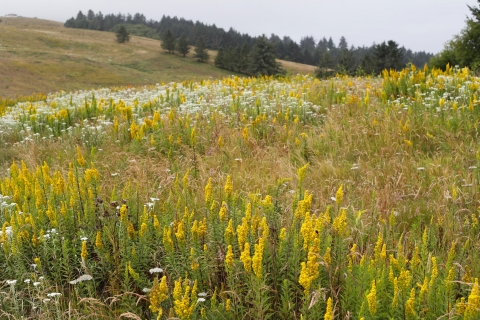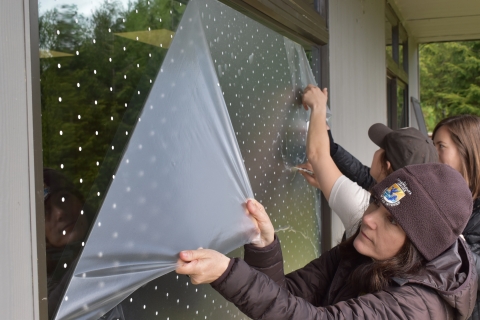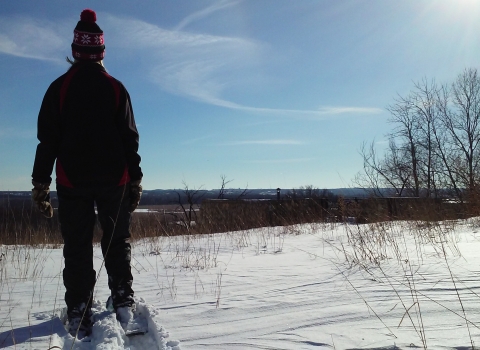Dawn Harris was worried.
It was 48 degrees and raining, a classic April day on the Oregon coast. Harris, the visitor services manager for the Oregon Coast National Wildlife Refuge Complex, and a team of eight were on their way to retrofit windows on one of Nestucca Bay National Wildlife Refuge’s buildings. Harris knew that for the install to work, the temperature needed to be at least 50 degrees with clear skies.
“I was worried,” Harris said. “I thought maybe we’d all get to the refuge and not be able to do it.”
The project was something Harris felt passionate about. After working for the refuge for 23 years, Harris was deeply and personally committed to both serving the visiting public as well as making sure that the refuge was a safe harbor for animals and native plants. Harris had heard reports from staff and volunteers that birds were flying into the windows of one of the refuge’s buildings, a multi-use structure structure
Something temporarily or permanently constructed, built, or placed; and constructed of natural or manufactured parts including, but not limited to, a building, shed, cabin, porch, bridge, walkway, stair steps, sign, landing, platform, dock, rack, fence, telecommunication device, antennae, fish cleaning table, satellite dish/mount, or well head.
Learn more about structure that includes refuge housing, a bunkhouse and an office. Some of the windows are nearly floor to ceiling, and Harris said you can really see the reflection of the forest behind the building. They were an obvious hazard for birds.
“Some of the windows are really big,” Harris said. “Almost anytime I was in the building and the shades weren’t drawn, I always felt dread because I knew how often birds hit those windows.”
Harris reached out to Jenn Urmston, a biologist with the U.S. Fish and Wildlife Service’s Migratory Birds program who is a part of a national effort to retrofit buildings to make windows more bird friendly. Urmston let Harris know there was currently some internal financial assistance to help cover the expense, and Harris jumped at the opportunity.
“As an agency, we want to set a good example and make changes that benefit birds,” Urmston said. “Many of our refuges are leading the way by making their windows more bird friendly.”
Almost 1 billion birds collide with glass in the United States every year. Window collisions are one of the leading causes of death for wild birds (other top threats include habitat loss and predation from cats). Although tall buildings are a hazard for birds, most collisions occur at low-rise buildings, and at urban and rural residences. When birds see reflections in a window of a natural landscape – clouds in the sky, trees or a garden – they perceive it as an extension of the world around them. Birds are also attracted to light, especially at night, and may intentionally fly toward lighted buildings.
One way to reduce daytime bird collisions is to make windows look less transparent. There are different types of window treatments, including curtains, paint, netting, tape and decals. Treatments are often inexpensive, ranging from just a few cents per square foot to a few dollars. Drawing blinds and turning off lights at night can help, and homeowners can also get creative with tempera paint, zen curtains or window decals covering the entire window (no more than 2 inches apart).
“There are so many problems we face in the Service that have complex solutions,” Urmston said. “Retrofitting windows is a simple and inexpensive way to have a big impact.”
Urmston coordinates with the Infrastructure and Management Division, a part of the Service’s refuges program, to help jump start the purchase of bird-friendly window films and makes sure the products being ordered are most effective at preventing bird strikes. For this building, Harris and Urmston decided on Feather Friendly's Harmony Dots window film. They chose this option because the dots are spaced 2 inches apart, but the pattern still allows ample light and it does not obstruct the view.
The manufacturer of the window treatment advised that the install needed to be completed when conditions were warm and dry. As Harris, Urmston and the others were driving over to Nestucca, the weather wasn’t cooperating. But in a sign of things to come, by the time they reached the refuge, the sky cleared.
“By the time we watched the installation video and got started, the sun came out,” Harris said. “It warmed up and we had perfect weather, which was great.”
Harris had assumed the installation of the window treatments would take all day. Instead, they were done in three hours.
“It went much faster than we expected,” Harris said. “We went slower with the first few, but after we got the hang of it, the install went really quickly.”
The first thing the application team needed to do was carefully measure the windows and cut out pieces of the film to fit the windows. They laid them out carefully to make sure the pattern was correct.
The rest of the process was like a combination of putting on a phone screen protector and a temporary tattoo. First, they cleaned the windows thoroughly to make sure there wasn’t a speck of dirt before applying the treatment. Next, they carefully laid the patterned roll of film on the windows, then squeegeed it on to remove any air bubbles. The last step was to peel off the applicator, leaving the pattern on the window. Unlike a temporary tattoo, however, the diamond dot design on the windows is more permanent. Cleaning windows with the dots is easy – it's just like cleaning any other window – and the dots can be removed by scraping them off.
“You put the whole sheet on the window,” Dawn explained. “You squeegee it on and make sure that everything is just the way you want. When you pull the film layer off, it leaves perfect little dots.”
There were more than two dozen windows: four floor-to-ceiling plate-glass windows, two sliding doors and 20 smaller windows. The four Service employees and four staff and interns from Oregon Youth Authority work program got so good at applying the treatments that Harris said she thought after their initial learning curve they were as proficient as professionals.
"We were able to get it all done with an enthusiastic team,” Harris said. “I’m here to say that anyone, and any refuge, could do it.”
Harris talked about the sense of relief she felt knowing birds wouldn’t hit the windows when the blinds were open.
“The whole winter, we kept encouraging people to leave those blinds closed, which makes the interior feel dark,” Harris said. “And now I feel a sense of relief. I was like, wow, I can actually open these blinds and not feel anxiety over killing birds.”
For more information on bird collisions and ways to help, you can visit the bird collisions webpage on the U.S. Fish and Wildlife Service website.






